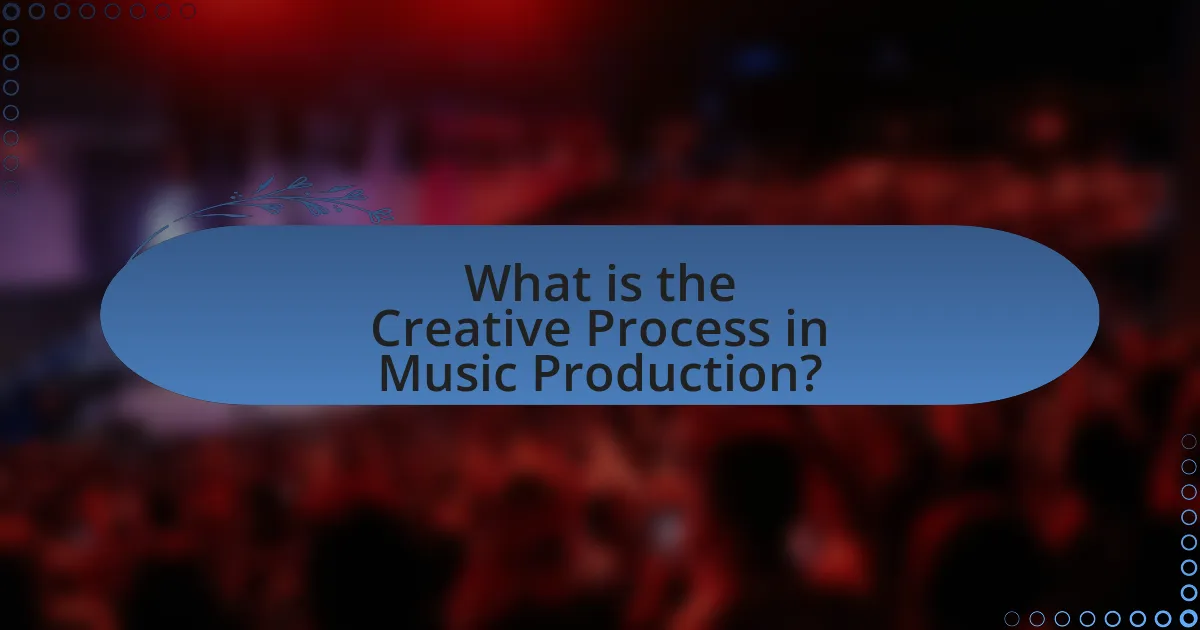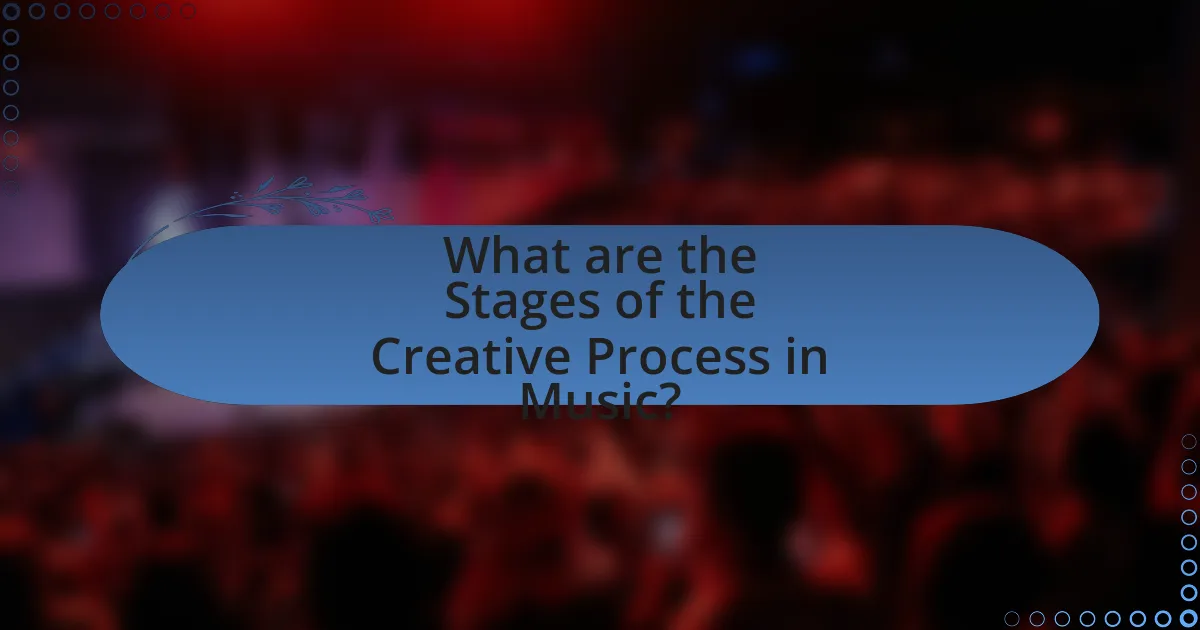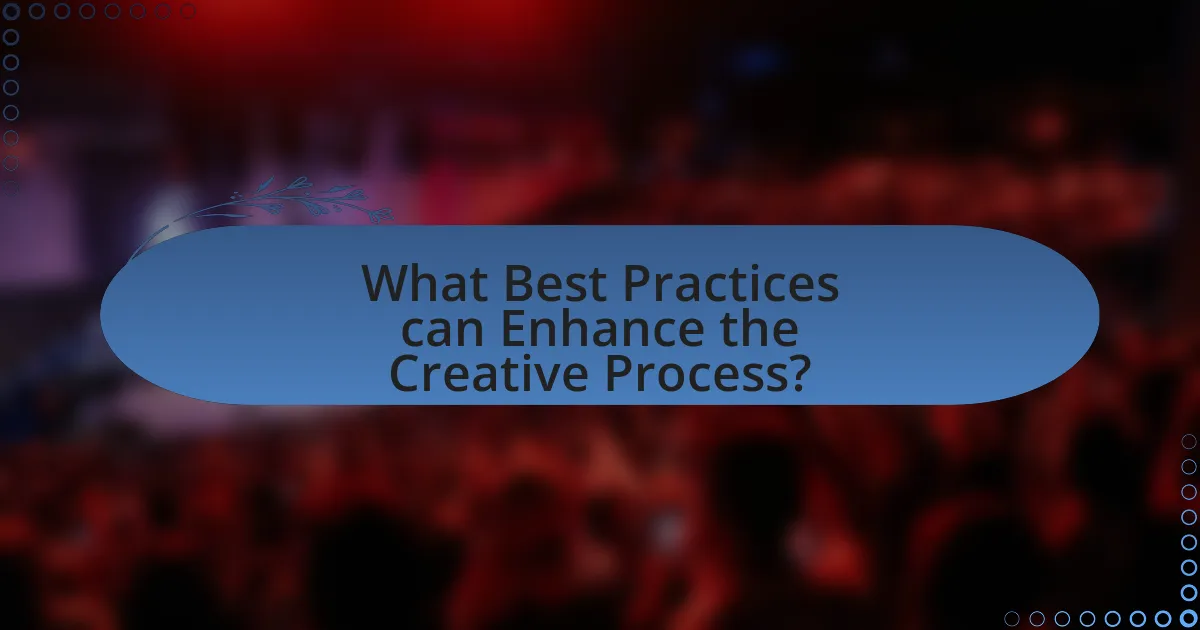The article explores the creative process in music production, detailing the stages from initial conception to the final polished track. It highlights the significance of jam sessions in fostering collaboration and innovation among musicians, as well as the challenges faced during the transition from spontaneous ideas to structured compositions. Key elements such as the role of technology, best practices for enhancing creativity, and methods for maintaining motivation throughout the production process are also discussed. The article emphasizes the importance of structured feedback and the avoidance of common pitfalls to optimize creative output in music.

What is the Creative Process in Music Production?
The creative process in music production involves a series of stages that transform initial ideas into a polished final product. This process typically includes conception, arrangement, recording, mixing, and mastering. During conception, artists brainstorm and develop musical ideas, often through jam sessions or improvisation, which serve as the foundation for the track. Arrangement follows, where the structure of the song is outlined, determining the order of verses, choruses, and bridges.
Recording captures the performance of instruments and vocals, utilizing various techniques to achieve the desired sound. Mixing then combines these elements, balancing levels, applying effects, and enhancing the overall sonic quality. Finally, mastering prepares the mixed track for distribution, ensuring it meets industry standards for playback across different platforms. This structured approach is supported by industry practices, as evidenced by the widespread use of digital audio workstations (DAWs) that facilitate each stage of production.
How do Jam Sessions contribute to the Creative Process?
Jam sessions significantly enhance the creative process by fostering spontaneous collaboration among musicians. During these sessions, artists experiment with new ideas, melodies, and rhythms in a low-pressure environment, which encourages innovation and exploration. Research indicates that improvisational settings, like jam sessions, stimulate brain activity associated with creativity, allowing musicians to break free from conventional patterns and develop unique sounds. For instance, a study published in the journal “Psychology of Music” found that collaborative improvisation leads to increased creative output and the generation of novel musical ideas. This dynamic interaction not only strengthens individual skills but also cultivates a sense of community, further enriching the creative experience.
What elements are typically present in a Jam Session?
A jam session typically includes musicians improvising together, a variety of musical instruments, and a collaborative atmosphere. During these sessions, participants often engage in spontaneous musical creation, allowing for the exploration of different genres and styles. The presence of a rhythm section, such as drums and bass, is common, as it provides a foundation for the improvisation. Additionally, musicians may take turns soloing, showcasing their individual skills while contributing to the collective sound. This dynamic interaction fosters creativity and can lead to the development of new musical ideas.
How do musicians collaborate during Jam Sessions?
Musicians collaborate during jam sessions by improvising together, exchanging musical ideas, and building on each other’s contributions. This spontaneous interaction allows them to explore different rhythms, melodies, and harmonies in real-time, fostering creativity and synergy. Research indicates that such collaborative environments enhance musical communication and lead to innovative compositions, as musicians adapt to one another’s playing styles and cues. For instance, studies have shown that improvisational collaboration can significantly improve group cohesion and individual musicianship, making jam sessions a vital part of the creative process in music.
Why is the transition from Jam Sessions to Finished Tracks important?
The transition from jam sessions to finished tracks is important because it transforms spontaneous musical ideas into polished, structured compositions. This process allows musicians to refine their creativity, ensuring that the most compelling elements of their improvisations are captured and developed into cohesive pieces. Additionally, finished tracks facilitate broader distribution and audience engagement, as they can be shared on various platforms, reaching listeners who may not have access to live performances. The ability to produce high-quality recordings also enhances a musician’s professional credibility and marketability in the music industry.
What challenges arise during this transition?
During the transition from jam sessions to finished tracks, several challenges arise, including maintaining creative momentum, managing differing artistic visions, and navigating technical limitations. Creative momentum can be difficult to sustain as the spontaneous energy of jam sessions often diminishes in the structured environment of production. Differing artistic visions among collaborators can lead to conflicts, making it challenging to reach a consensus on the direction of the track. Additionally, technical limitations, such as inadequate recording equipment or software proficiency, can hinder the realization of the creative ideas generated during jam sessions. These challenges are commonly faced in the music production process, as highlighted by various studies on collaborative creativity in music.
How can musicians maintain creativity while refining their work?
Musicians can maintain creativity while refining their work by incorporating diverse influences and regularly experimenting with new techniques. Engaging with various genres, collaborating with other artists, and utilizing different instruments can inspire fresh ideas and perspectives. Research indicates that exposure to a wide range of musical styles enhances creativity, as demonstrated in a study by Hargreaves and North (1999), which found that musicians who explore multiple genres develop a more versatile skill set and innovative approaches to their craft. Additionally, setting aside time for improvisation and free-form jam sessions allows musicians to explore their creativity without the constraints of perfection, fostering an environment where new ideas can flourish.

What are the Stages of the Creative Process in Music?
The stages of the creative process in music typically include preparation, incubation, illumination, and verification. In the preparation stage, musicians gather ideas, skills, and knowledge relevant to their project. The incubation stage involves letting ideas simmer subconsciously, often leading to unexpected insights. Illumination occurs when a breakthrough idea or melody emerges, often described as a moment of inspiration. Finally, the verification stage involves refining and finalizing the music, ensuring it meets the desired artistic vision. This framework is supported by research in creativity studies, which emphasizes these stages as common patterns in artistic endeavors.
How do initial ideas develop into structured compositions?
Initial ideas develop into structured compositions through a systematic process of refinement and organization. This process typically begins with brainstorming, where raw concepts are generated without judgment, followed by selecting the most promising ideas. Once selected, these ideas undergo further development, often involving outlining the composition’s structure, such as defining sections like verses, choruses, and bridges.
As the composition evolves, elements such as melody, harmony, and rhythm are integrated, ensuring coherence and flow. Feedback from collaborators or audiences can also play a crucial role in shaping the final piece, leading to revisions that enhance clarity and impact. This iterative process is supported by established practices in music theory and composition techniques, which provide frameworks for organizing musical ideas effectively.
What techniques can be used to capture spontaneous ideas?
Techniques to capture spontaneous ideas include brainstorming, mind mapping, and using voice recorders. Brainstorming allows individuals to generate a large number of ideas quickly without judgment, fostering creativity. Mind mapping visually organizes thoughts, helping to connect and expand on spontaneous ideas. Voice recorders enable immediate capture of thoughts, ensuring that fleeting ideas are not forgotten. These methods are effective in creative processes, as they facilitate the flow of ideas and enhance the likelihood of innovation.
How do musicians select which ideas to pursue further?
Musicians select which ideas to pursue further by evaluating the emotional resonance and originality of their concepts. They often consider how an idea aligns with their artistic vision and whether it evokes a strong response from themselves or their collaborators. For instance, during jam sessions, musicians may identify compelling riffs or lyrics that spark excitement, leading them to develop those ideas into full compositions. Research indicates that emotional engagement significantly influences creative decision-making, as seen in studies on artistic expression and cognitive processes.
What role does technology play in the Creative Process?
Technology plays a crucial role in the creative process by providing tools that enhance creativity, streamline workflows, and facilitate collaboration. Digital audio workstations (DAWs), for instance, allow musicians to compose, edit, and produce music with precision and flexibility, significantly reducing the time from concept to finished track. According to a study published in the Journal of New Music Research, the use of DAWs has increased the efficiency of music production by up to 50%, enabling artists to experiment with sounds and arrangements that would be difficult to achieve with traditional methods. Additionally, technology fosters collaboration across distances through platforms like cloud storage and communication tools, allowing artists to work together in real-time regardless of their physical location. This integration of technology not only democratizes the creative process but also expands the possibilities for innovation in various artistic fields.
How do digital tools enhance collaboration during Jam Sessions?
Digital tools enhance collaboration during Jam Sessions by facilitating real-time communication and seamless sharing of ideas among participants. These tools, such as collaborative software and cloud-based platforms, allow musicians to record, edit, and share their contributions instantly, fostering a more dynamic and interactive creative environment. For instance, platforms like Soundtrap and Splice enable users to work together remotely, providing features like version control and integrated chat, which streamline the collaborative process. This immediate access to shared resources and feedback accelerates the creative workflow, leading to more innovative outcomes in music production.
What software is commonly used in the production of Finished Tracks?
Digital Audio Workstations (DAWs) are commonly used in the production of finished tracks. Popular DAWs include Ableton Live, Logic Pro, Pro Tools, and FL Studio, which provide comprehensive tools for recording, editing, and mixing audio. These software applications are industry standards, widely adopted by music producers and sound engineers for their robust features and user-friendly interfaces, facilitating the entire creative process from initial composition to final mastering.

What Best Practices can Enhance the Creative Process?
Best practices that can enhance the creative process include setting clear goals, fostering a collaborative environment, and allowing for experimentation. Clear goals provide direction and focus, which can streamline the creative efforts and lead to more effective outcomes. A collaborative environment encourages diverse perspectives and ideas, which can spark innovation and creativity. Allowing for experimentation enables individuals to explore new concepts without the fear of failure, leading to unexpected and valuable insights. Research indicates that environments that support these practices can significantly boost creative output, as seen in studies conducted by the University of Michigan, which found that collaboration and goal-setting are key drivers of creativity in group settings.
How can musicians foster a productive Jam Session environment?
Musicians can foster a productive jam session environment by establishing clear communication and mutual respect among participants. Effective communication ensures that all musicians understand each other’s ideas and contributions, which enhances collaboration. For instance, setting ground rules, such as taking turns to solo or share ideas, can prevent confusion and promote a more organized flow of creativity. Additionally, mutual respect allows musicians to feel valued, encouraging them to express themselves freely. Research indicates that environments where participants feel safe to share ideas lead to higher levels of creativity and innovation, as seen in studies on group dynamics in creative settings.
What strategies can be employed to encourage creativity among participants?
To encourage creativity among participants, implementing collaborative brainstorming sessions is effective. These sessions foster an open environment where individuals can share ideas without judgment, leading to innovative solutions. Research by Osborn (1953) in “Applied Imagination” highlights that group brainstorming can generate more ideas than individuals working alone, as it leverages diverse perspectives. Additionally, incorporating play and experimentation into activities allows participants to explore concepts freely, enhancing creative thinking. A study by F. M. Amabile (1996) in “Creativity in Context” supports this, indicating that intrinsic motivation and a supportive environment significantly boost creativity.
How can feedback be effectively integrated into the process?
Feedback can be effectively integrated into the creative process by establishing structured feedback loops that encourage continuous improvement. This involves regularly soliciting input from collaborators and stakeholders at various stages of the creative process, such as during jam sessions and after initial drafts of tracks. Research indicates that incorporating feedback at multiple points enhances the quality of the final product, as it allows for adjustments based on diverse perspectives and expertise. For instance, a study published in the Journal of Creative Behavior found that iterative feedback significantly improved creative outcomes in collaborative projects.
What are common pitfalls to avoid in the Creative Process?
Common pitfalls to avoid in the creative process include perfectionism, lack of structure, and fear of failure. Perfectionism can stifle creativity by causing individuals to overanalyze their work, leading to paralysis and inaction. A lack of structure may result in disorganization, making it difficult to progress from initial ideas to finished products. Fear of failure can inhibit risk-taking, which is essential for innovation and exploration in creative endeavors. Research indicates that embracing imperfection and establishing a flexible framework can enhance creativity and productivity, as seen in studies on creative problem-solving techniques.
How can musicians overcome creative blocks during production?
Musicians can overcome creative blocks during production by implementing structured techniques such as setting specific goals, taking breaks, and collaborating with others. Setting clear, achievable goals helps to focus creativity and provides direction, which can alleviate feelings of being overwhelmed. Research indicates that taking breaks can enhance productivity and creativity, as it allows the mind to rest and reset, leading to fresh ideas. Collaboration with other musicians introduces new perspectives and ideas, which can stimulate creativity and break through mental barriers. These methods are supported by studies showing that structured approaches to creativity can lead to improved outcomes in artistic endeavors.
What methods can help maintain motivation throughout the process?
Setting clear, achievable goals helps maintain motivation throughout the creative process. By breaking down larger projects into smaller, manageable tasks, individuals can experience a sense of accomplishment as they complete each step. Research indicates that goal-setting enhances motivation by providing direction and a clear focus, which is essential in creative endeavors. Additionally, incorporating regular feedback loops allows creators to assess their progress and make necessary adjustments, further sustaining their motivation. Studies show that positive reinforcement, such as celebrating small wins, can significantly boost morale and encourage continued effort in creative projects.